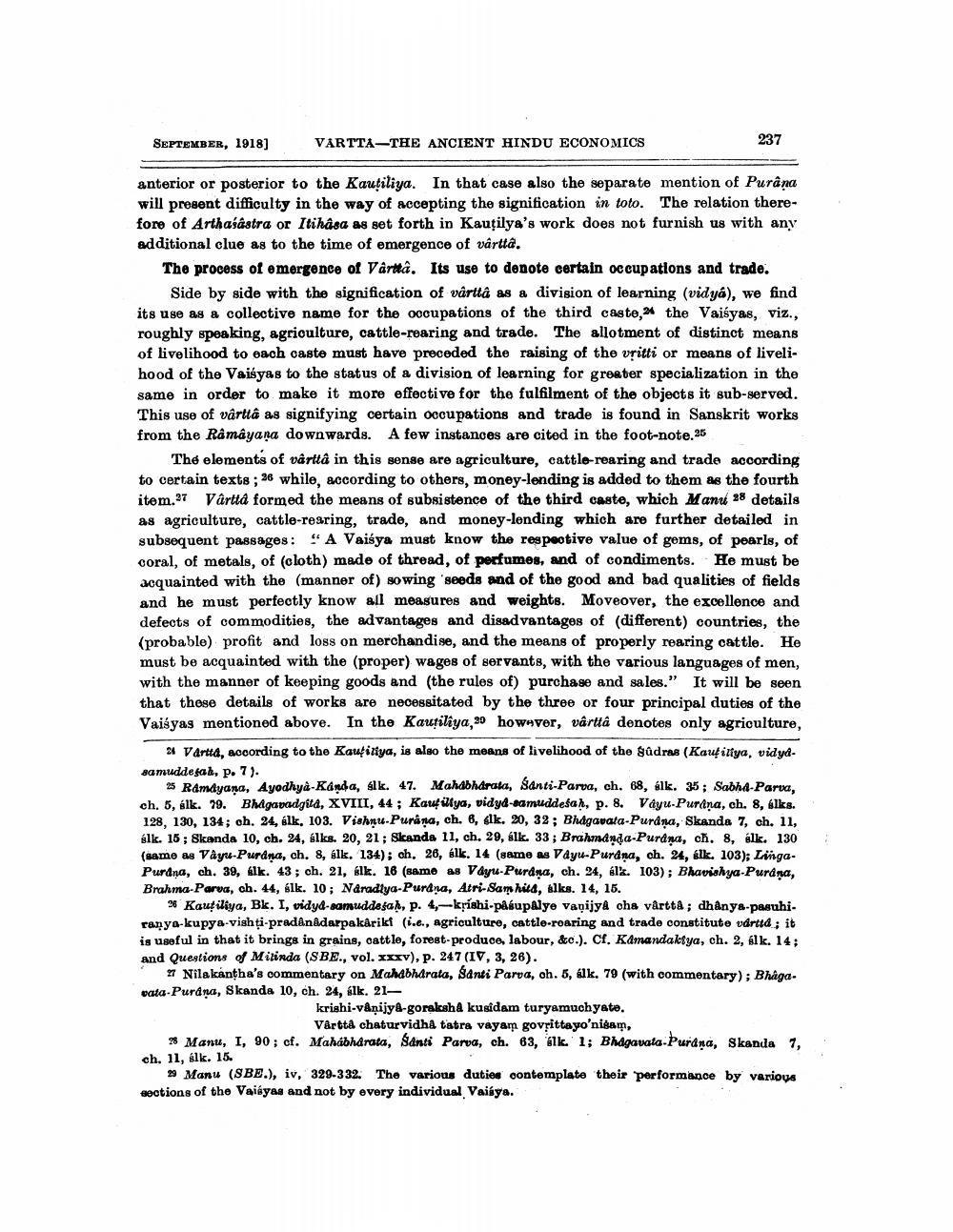________________
SEPTEMBER, 1918]
VARTTA-THE ANCIENT HINDU ECONOMICS
237
anterior or posterior to the Kautiliya. In that case also the separate mention of Purâna will present difficulty in the way of accepting the signification in toto. The relation therefore of Arthasastra or Itihasa as set forth in Kautilya's work does not furnish us with any additional clue as to the time of emergence of vartta.
The process of emergence of Vartta. Its use to denote certain occupations and trade.
Side by side with the signification of varitâ as a division of learning (vidya), we find its use as a collective name for the occupations of the third caste, the Vaisyas, viz., roughly speaking, agriculture, cattle-rearing and trade. The allotment of distinct means of livelihood to each caste must have preceded the raising of the vritti or means of livelihood of the Vaisyas to the status of a division of learning for greater specialization in the same in order to make it more effective for the fulfilment of the objects it sub-served. This use of vartta as signifying certain occupations and trade is found in Sanskrit works from the Ramayana downwards. A few instances are cited in the foot-note.25
The elements of varità in this sense are agriculture, cattle-rearing and trade according to certain texts ; 26 while, according to others, money-lending is added to them as the fourth item.27 Vârtta formed the means of subsistence of the third caste, which Manu 28 details as agriculture, cattle-rearing, trade, and money-lending which are further detailed in subsequent passages: "A Vaiấya must know the respeotive value of gems, of pearls, of coral, of metals, of (cloth) made of thread, of perfumes, and of condiments. He must be acquainted with the (manner of) sowing 'seeds and of the good and bad qualities of fields and he must perfectly know all measures and weights. Moveover, the excellence and defects of commodities, the advantages and disadvantages of different) countries, the (probable) profit and loss on merchandise, and the means of properly rearing cattle. He must be acquainted with the (proper) wages of servants, with the various languages of men, with the manner of keeping goods and the rules of) purchase and sales." It will be seen that these details of works are necessitated by the three or four principal duties of the Vaišyas mentioned above. In the Kauriliya, 39 however, vârtta denotes only agriculture,
24 Vartta, according to the Kaufitiya, is also the means of livelihood of the gûdras (Kautilya, vidydsamuddesak, p. 7).
25 Ramdyana, Ayodhya Kanda, alk. 47. Mahabharata, Santi-Parva, ch. 68, 4lk. 35: Sabha Parva. ch. 5, élk. 79. Bhagavadgita, XVIII, 44; Kautilya, vidyd-eamuddeśaḥ, p. 8. Váyu-Purana, ch. 8, alks. 128. 130. 134: ch. 24, lk, 103. Vishnu.Purana, ch. 6, elk. 20, 32; Bhdgavata Purana. Skanda 7, ch. 11, slk. 15; Skanda 10, ch. 24, slks. 20, 21; Skanda 11, ch. 29, slk. 33; Brahmanda-Purana, cħ. 8, alk. 130 (same as Vayu-Purdna, ch. 8, 6lk, 134); ch. 26, slk. 14 (same as Vayu-Purana, ch. 24, slk. 103); Linga. Purdna, ch. 39, alk. 43; ch. 21, elk. 16 (same as Vayrı-Purdna, ch. 24, bls. 103); Bhavishya Purana, Brahma-Parva, ch. 44, slk. 10; Naradlya-Purana, Atri-Samhita, slks. 14, 15.
26 Kautiliya, Bk. I, vidya-samuddesah, p. 4,--krishi-påsupalye vanijya cha vårtta; dhânye-pasuhi. ranya-kupys-vishți-pradanadarpakäriki (i.e., Agriculture, cattle-roaring and trade constitute varit ; it is useful in that it brings in grains, cattle, forest-produce, labour, &c.). Cf. Kamandaktya, ch. 2, alk. 14; and Questions of Mitinda (SBE., vol. xxxv), p. 247 (IV, 3, 26).
27 Nilakantha's commentary on Mahabharata, Santi Parva, oh. 5, 6lk, 79 (with commentary); Bhaga. vata-Purdna, Skanda 10, ch. 24, slk. 21–
krishi-vånijya-goraksha kusidam turyamuchyate.
Vartta chaturvidhå tatra vayam govșittayo'nisam, 28 Manu, I, 90; cf. Mahabharata, Santi Parva, ch. 63, 6lk. 1; Bhagavata-Purana, Skanda 1, ch. 11, alk. 15.
29 Manu (SBE.), iv, 329-332. The various duties contemplate their performance by various sections of the Vaidyas and not by every individual Vaibya.




